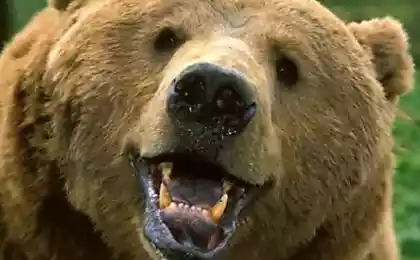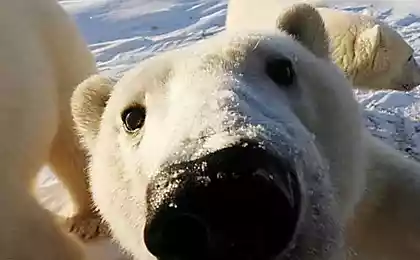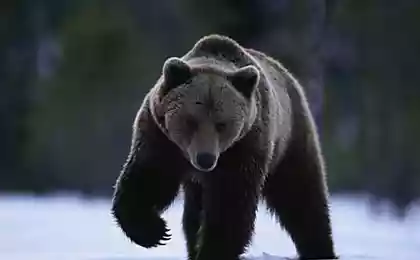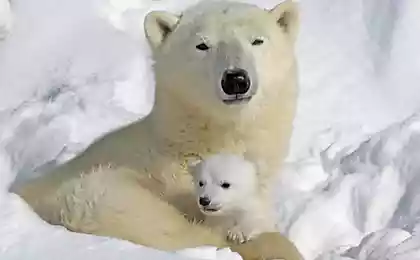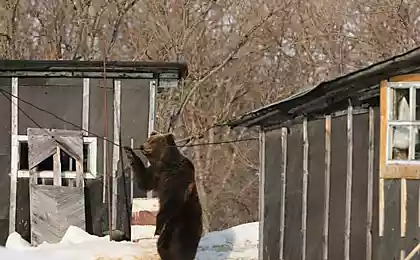1452
Polar bears emerge from their dens after hibernation
I offer you a selection of interesting and unusual photos of polar bears with cubs, which are selected from their dens after hibernation.
Photographer Steve Bloom spent a lot of time in the Arctic regions of Norway and Canada, taking pictures of these amazing animals.

The photo - bear with cubs in Canada.

Every winter, the female polar bear digs a den where they give birth to cubs - typically two kids there, but in exceptional cases the number may reach four. The cubs are born around the time of the beginning of winter, probably in December and January. A cozy den in the snow, warm side by mother's milk, which she nurtures children and which is rich in fat and very nutritious, allows kids to be warm and to grow rapidly until they finally leave the den, accompanied by his mother in March or April. The photo - bear with cubs in Churchill, Canada.

For several days after the first release of a bear den, accompanied by cubs make only short outing - it is necessary that the kids used to the low ambient temperature. Then the family leaves the den forever and moves towards the sea. There, on the ice, the mother teaches the kids to hunt, swim and survive in harsh climatic conditions. In the photo - the polar bear cub watches the playing in the snow-covered woods of Canada.

After nearly two years together, the family breaks up, and the whole cycle starts over again. In the photo: two families of polar bears on ice not far from Churchill, Canada.

Photograph of a polar bear is not easy, it all depends on how much you're lucky, Will you be the right place at the right time, and in addition, the weather conditions and all - on your luck, "says Steve Bloom ... Imagine a world without polar bears . It seems unthinkable, but in the course of climate change is rapidly gaining momentum, arctic ice floes, which spend most of their life polar bears begin to melt. In the next few years, it can be absolutely disastrous for this truly amazing animal that stood up on its hind legs will be taller than the tallest elephant. The photo - a polar bear dives into the water in Norway.

"The most important thing is that the bear is one of those animals, the size of which managed to keep thanks to the program of protection and conservation: There is an international agreement that regulates the hunting of polar bears," said Steve. In the photo: Polar bear scratching his chest, Canada.
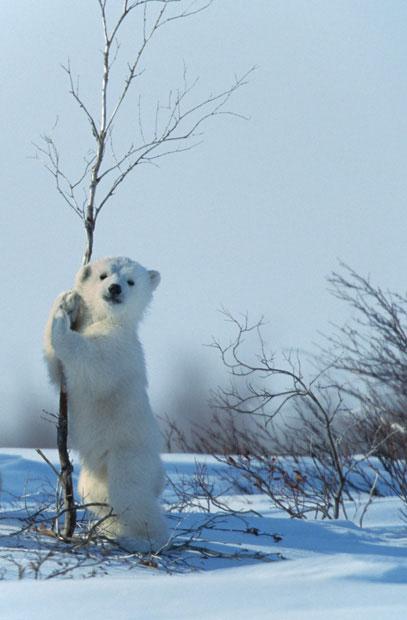
A baby polar bear near birch, Canada.
Bill and coo of polar bears near Churchill, Canada.

Polar bears in the snow on the coast Woodfjorden Shpittsebergene in Norway.
A female polar bear cub at the carcass of a whale, Norway.
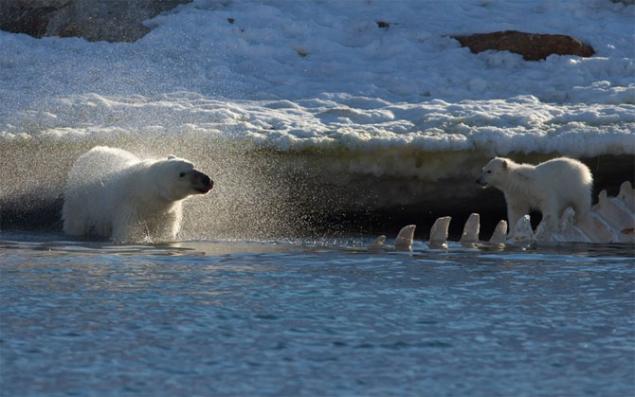
Paws polar bear, Canada.

The male polar bear looks at his reflection in the water.

Polar Bear, Churchill, Canada.

Two polar bears have converged in the comic struggle, Churchill, Canada.

Polar bear lying in snow, Churchill, Canada.

Source: asaratov.livejournal.com
Photographer Steve Bloom spent a lot of time in the Arctic regions of Norway and Canada, taking pictures of these amazing animals.

The photo - bear with cubs in Canada.

Every winter, the female polar bear digs a den where they give birth to cubs - typically two kids there, but in exceptional cases the number may reach four. The cubs are born around the time of the beginning of winter, probably in December and January. A cozy den in the snow, warm side by mother's milk, which she nurtures children and which is rich in fat and very nutritious, allows kids to be warm and to grow rapidly until they finally leave the den, accompanied by his mother in March or April. The photo - bear with cubs in Churchill, Canada.

For several days after the first release of a bear den, accompanied by cubs make only short outing - it is necessary that the kids used to the low ambient temperature. Then the family leaves the den forever and moves towards the sea. There, on the ice, the mother teaches the kids to hunt, swim and survive in harsh climatic conditions. In the photo - the polar bear cub watches the playing in the snow-covered woods of Canada.

After nearly two years together, the family breaks up, and the whole cycle starts over again. In the photo: two families of polar bears on ice not far from Churchill, Canada.

Photograph of a polar bear is not easy, it all depends on how much you're lucky, Will you be the right place at the right time, and in addition, the weather conditions and all - on your luck, "says Steve Bloom ... Imagine a world without polar bears . It seems unthinkable, but in the course of climate change is rapidly gaining momentum, arctic ice floes, which spend most of their life polar bears begin to melt. In the next few years, it can be absolutely disastrous for this truly amazing animal that stood up on its hind legs will be taller than the tallest elephant. The photo - a polar bear dives into the water in Norway.

"The most important thing is that the bear is one of those animals, the size of which managed to keep thanks to the program of protection and conservation: There is an international agreement that regulates the hunting of polar bears," said Steve. In the photo: Polar bear scratching his chest, Canada.

A baby polar bear near birch, Canada.
Bill and coo of polar bears near Churchill, Canada.

Polar bears in the snow on the coast Woodfjorden Shpittsebergene in Norway.
A female polar bear cub at the carcass of a whale, Norway.

Paws polar bear, Canada.

The male polar bear looks at his reflection in the water.

Polar Bear, Churchill, Canada.

Two polar bears have converged in the comic struggle, Churchill, Canada.

Polar bear lying in snow, Churchill, Canada.

Source: asaratov.livejournal.com
